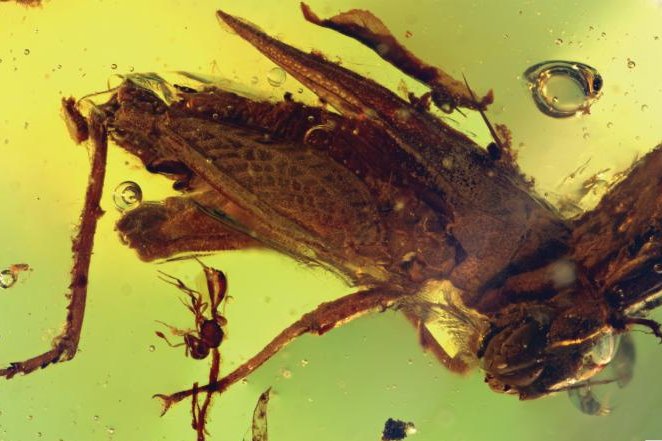An ancient species of cricket, found in neglected amber artifacts. (Sam Heads/INHS/ZooKeys)
CHAMPAIGN, Ill., July 30 (UPI) -- A previously unknown ancient cricket species has been discovered in a piece of hardened amber.
The amber was discovered more than half a century ago in the Dominican Republic among hundreds of amber pieces. But most of these artifacts, like the one containing the newly found locust, have been sitting neglected at the bottom of a bucket in lab storage.
Neglected no longer, researchers at the University of Illinois have recently reexamined the amber catalogue, finding a number of impressive specimens. This cricket species, which lived some 20 million years ago, is particularly special because it represents a new chapter in the evolutionary life of a subfamily of locusts called Cladonotinae.
Most modern locusts don't have wings, nor do most of them fly in any traditional sense. But almost all of their ancient ancestors had wings and did fly. This ancient pygmy grasshopper, dubbed Electrotettix attenboroughi (for beloved naturalist and TV personality David Attenborough), had small wings that were no longer useful for flying -- a sort of evolutionary stop over on the way from winged to wingless.
"We wouldn't exactly call it a missing link," explained Sam Heads, a paleontologist at the Illinois Natural History Survey (INHS), which is part of the Prairie Research Institute at the University of Illinois. "But it's certainly an interesting intermediate between a fully winged ancestor and a wingless descendent."
"Grasshoppers are very rare in amber and this specimen is extraordinarily well-preserved," Heads added.
The grasshopper was discovered inside a type of amber that also trapped wasps, ants, midges, plant remnants and fungi. Heads says these specimens offer clues as to the kind of environment they once thrived in.
The treasure trove of amber was first collected by INHS entomologist Milton Sanderson in the Dominican Republic in the 1950s. Now, after years of abandonment in Illinois, the collection is being appreciated once again, by Head and his colleagues.
Their new and improved findings were detailed in the latest edition of the journal ZooKeys.
"Fossil insects can provide lots of insight into the evolution of specific traits and behaviors, and they also tell us about the history of the time period," Heads said. "They're a tremendous resource for understanding the ancient world, ancient ecosystems and the ancient climate -- better even, perhaps, than dinosaur bones."















